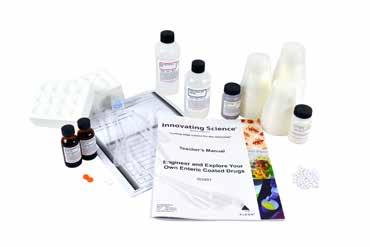
4 minute read
Biomedical Engineering
In this lab, students will learn the basic structures and pathway of the digestive system and understand the different functions of the stomach and the small intestine in regards to digestion. They will investigate how the properties of different enteric coatings react in different sections of the digestive system. Next they will explore the purpose of an enteric coating and make a simulated “coating” and engineer a coating most suitable for certain pharmaceutical needs. This lab was written by a Biomedical Engineer and has enough materials for 15 groups. Includes Teacher’s manual and student guide.
Kit Includes: 200mL Isopropyl alcohol 99% 34g Shellac orange flakes 4g Alginic acid sodium salt 2 x 25mL Hydrochloric acid 10M 150mL Sodium hydroxide 10M 2 Aspirin tablets, enteric-coated 2 Aspirin tablets, regular 50 5oz cups 30 Pipettes 45 Beads, white 1pkg Coverslips 15 Spot plates
Advertisement
DOT Info: UN1824, Sodium hydroxide solution, 8, II, Ltd Qty UN1219, Isopropanol, 3, II, Ltd Qty
WARNING: This product can expose you to chemicals including Acetyl Salicylic Acid/Aspirin, which is known to the State of California to cause reproductive harm. For more information go to www.P65Warnings.ca.gov.
IS3401 $61.75
Biomaterials to Make Your Own Contact Lenses
Engineers play an integral role in the process of finding a “perfect” material or ratio of materials to maximize the desired properties of an invention and decrease the amount of negative effects of other properties. For example, when developing the perfect material for use in contact lenses, an engineer will have to test many different materials before finding the right one. A hydrogel is a polymer similar to plastic that has favorable optical properties and favorable flexibility/strength but like paper and glasses/ceramics is hydrophilic, which is necessary for a contact lens to function properly. Testing a hydrogel, which is favorable for all three of the main properties needed for a contact lens to function properly, is the main job of a biomedical engineer developing contact lenses today. They make a hydrogel and find the perfect “ratio” of polymer to water. The composition of the hydrogel needs to be hydrophilic enough to maintain a wet environment in the eye but not too hydrophilic so that the contact begins to swell and change size and shape. Students will engineer a lens using 2 different materials. They will determine the correct material and the concentration that has similar properties as a contact lens, while discovering the correct optical properties, tensile strength and hydrophobicity. Kit contains enough materials for 15 groups. Teacher’s Manual and Student Study Guide copymasters are included.
Kit Includes: 300g Gelatin Powder 15 pcs Zinc Metal 15 Plastic Pipettes 45 Petri Dishes 1pkg Glass Cover Slips 15 pcs Chromatography Paper 15 Plastic Microscope Slides 15 Glass Microscope Slides 1pkg Toothpicks 1 bar Soap

DOT Info: Non-regulated
IS3402
$75.20
Biomedical engineers design devices, equipment, and processes to improve medical treatment methods and the quality of human health and life. They apply engineering principles to biology and medicine to create products such as prosthetic limbs and artificial organs, among other things. One major focus of biomedical engineers is the design of drug delivery systems, which can control the transport and release of medicine in the body to more effectively treat diseases and illnesses. In this experiment, students will gain an understanding of drug delivery and its importance by testing simulated delivery systems in multiple environments that mimic different parts of the body. The delivery systems will be analyzed and compared, allowing students to engineer an optimal solution and learn what properties must be considered when designing new drug delivery systems. This lab has enough materials for 15 groups. Teacher’s manual and Student Study Guide copy masters included.
Kit Includes: 5g Simulated Drug 1L Hydrochloric Acid 1.0M 1L Sodium Hydroxide 1.0M 45 Hydrogel Delivery Systems 45 Plastic Delivery Systems 45 Cups, 5oz

DOT Info: UN1789, Hydrochloric acid, 8, III, Ltd Qty UN1824, Sodium hydroxide solution, 8, II, Ltd Qty
IS3403 $60.75
Engineer and Explore Materials for Prosthetics
In this lab, students will explore the materials that biomedical engineers use when creating prosthetic devices. They will first investigate the physical properties of various metals, ceramics, and polymers to understand how they differ, and determine which materials would be most suitable for use in a hip replacement prosthetic. Students will then engineer their own prosthetic arm that meets certain design requirements and mimics the functionality of a real hand. Kit contains enough materials for 15 groups. Teacher’s Manual and Student Study Guide copy masters are included.
Kit Includes: 15 Bone Pieces 30 Aluminum Strips 30 Cobalt Pieces 30 Brass Foil Strips 30 Zinc Pieces 30 Ceramic Tile Pieces 1pkg Glass Slides 30 Polyethylene Pieces 30 Rubber Stoppers 30 Balloons 15 Push Pins 15 Plastic Cups 20 Cardboard Pieces 2 Toothpick Packs 150 Plastic Stirrers 2 Sticky Connecting Putty Packs 150 Small Wooden Skewers 100 Rubber Bands 100 Straws 100 Wooden Craft Sticks 100 Index Cards Package of String
DOT Info: Non-regulated

IS3404 $299.00
CHOKING HAZARD
Children under 8 years can choke or suffocate on uninflated or broken balloons. Adult supervision required. Keep uninflated balloons from children. Discard broken balloons at once. WARNING: This product can expose you to chemicals including Phthalates, which is known to the State of California to cause reproductive harm. For more information go to www.P65Warnings.ca.gov.










